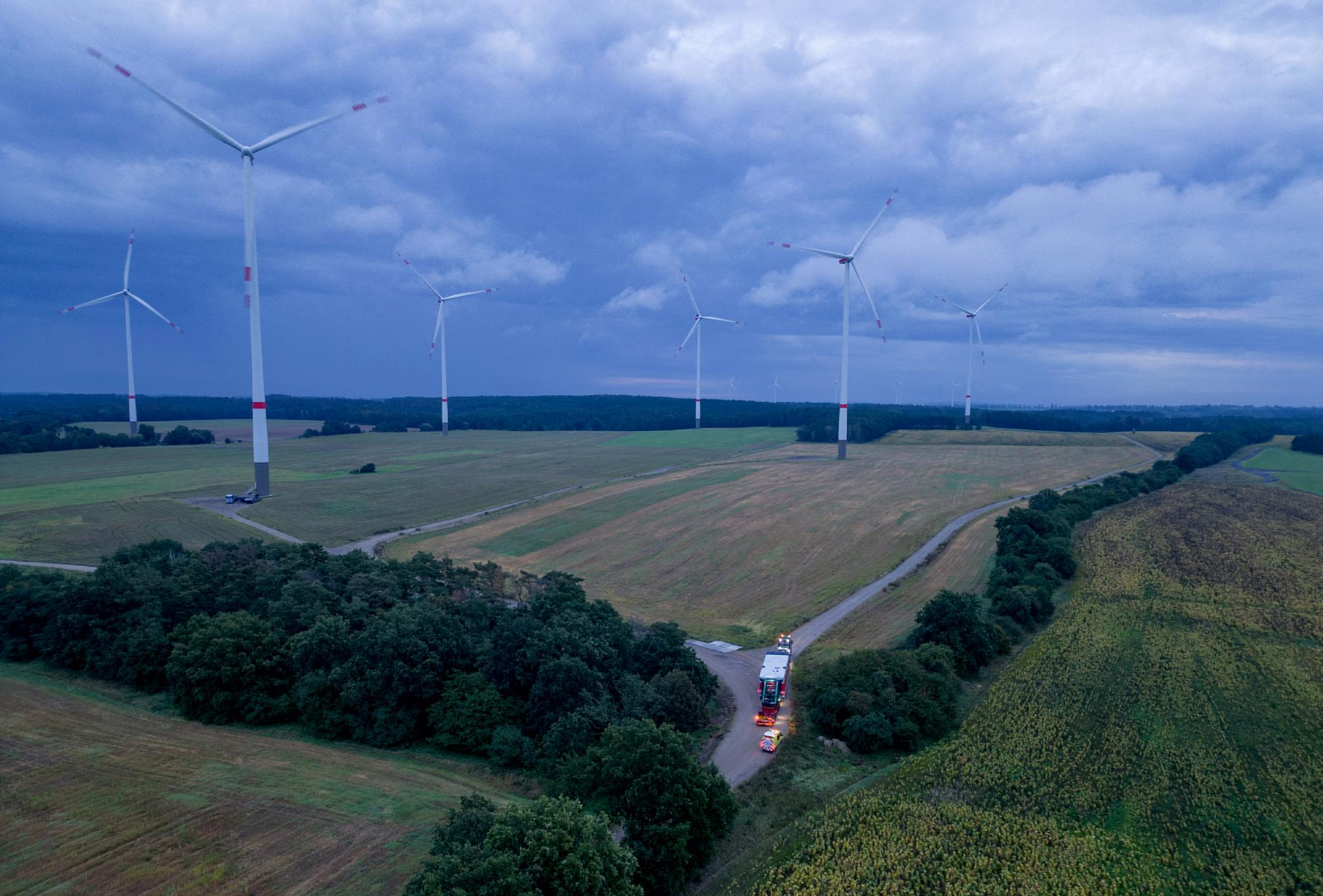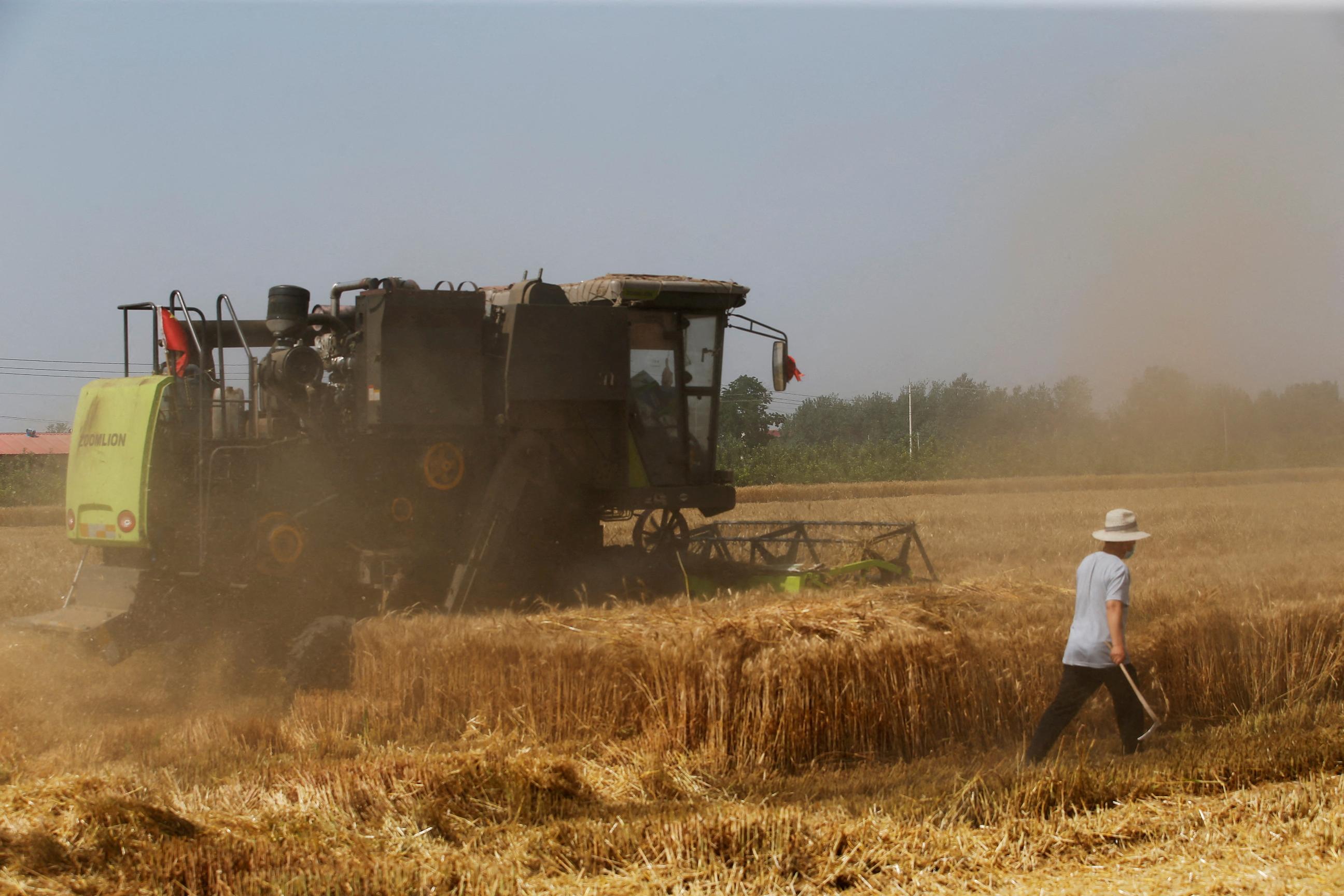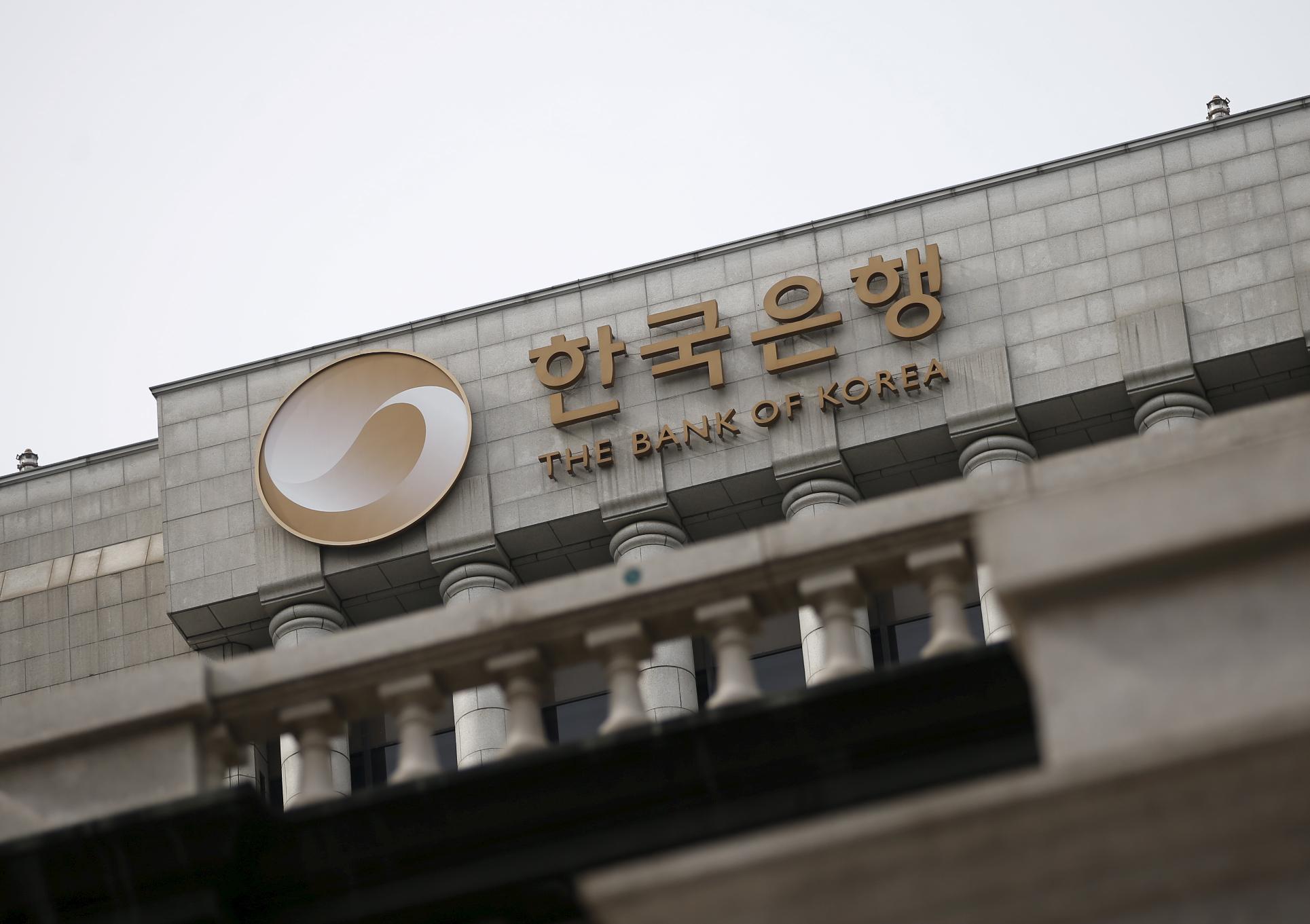
2024-08-22 06:02
LITTLETON, Colorado, Aug 22 (Reuters) - Wind generation in Germany is set to grow by only 1% in 2024, the slowest growth pace in 3 years, as low wind speeds alongside a slowdown in net generation capacity construction blunt the progress of the country's top source of electricity. Sluggish growth in the country's main power source may force utilities to increase generation from fossil fuels in late 2024, especially if industrial power use expands just as demand for household and commercial heating climbs over winter. Higher fossil fuel-fired generation by Europe's largest economy may in turn reverse the trend of power sector pollution in the country, which so far in 2024 has declined to its lowest levels in more than a decade. WIND'S PLATEAU Wind farms overtook coal-fired power plants as the main source of German electricity production for the first time in 2023, and wind remains the primary power source for the country so far in 2024. Wind power accounted for around 28% of Germany's utility-scale electricity generation through the first seven months of 2024, according to data from energy think tank Ember. That share is up from around 27% for 2023 as a whole, and exceeded coal's 19.5% and solar's 17.5% shares so far this year. Total electricity generation from wind farms dropped to its lowest level in over a year in July due to low wind speeds, which slump every summer due to relatively still conditions at turbine level during the hottest time of year. Wind generation levels are expected to rebound from September onwards as weather conditions change and wind speeds pick up, which should allow wind farms to further expand their share of overall electricity generation later in 2024. However, forecasts by LSEG suggest overall wind generation from September onwards may fall below prior-year totals, and result in a 12% decline in net generation during the final quarter from the same months in 2023. CHANGING FORECASTS LSEG's latest wind generation forecasts show that Germany's wind power will be 13,438 megawatt hours (MWh) in September, which would mark a 4,200 MWh or 46% gain over the generation total of September 2023. However, LSEG's forecasts for generation over the remaining months of the year look set to consistently fall below the year-before totals, by an average of nearly 12% for the final quarter of the year. If realized, those forecasts would equate to a full-year generation total of 196,189 MWh for 2024, which is up just 0.9% from 2023's full-year tally of 194,432 MWh. The less than 1% expansion in wind generation compares to a 12.4% annual growth rate in 2023 and a 11.2% expansion in 2022, and so could be viewed as a disappointment by clean energy advocates. And LSEG forecasts are bound to change as wind speeds and regional weather conditions evolve. But significant changes to Germany's wind generation infrastructure so far in 2024 also point to only modest growth potential for the year as a whole. CAPACITY EBBS & FLOWS Over the first half of 2024, the German wind sector had almost 900 new turbines with a collective generation capacity of 5,021 megawatts (MW) approved for connection to the country's grid, according to government data. That capacity figure was a record, and indicates federal authorities remain committed to maintaining clean power growth. However, the number of operational turbines in Germany actually shrank over the opening half of 2024, as 252 new turbines were connected to the grid while 282 turbines were decommissioned. The new turbines out-muscle their deactivated peers in terms of capacity, bringing 1,310 MW online to replace the 380 MW of shuttered capacity. Yet the actual generation potential of this newly reconfigured fleet remains unclear and at the mercy of wind speeds across key farms. Currently, LSEG's forecasts call for generation to slightly exceed long-term generation levels over the near term, but then drift consistently below average output rates later in the year due to slower-than-normal wind speeds. EMISSIONS IMPACT If those wind generation forecasts prove substantially accurate, then overall German wind output may post only modest year-on-year growth in 2024, despite the connection of newer and larger turbines. To make up for any power supply shortfall that may emerge, German power producers may be forced to boost output from coal and gas-fired plants, which have played only bit parts in the generation mix so far but remain integral to Germany's overall energy system. Through the first seven months of 2024, German fossil-fuel fired generation contracted by 14.5% from the same months in 2023 and was the lowest for that period on record, Ember data shows. German power sector emissions from fossil fuels dropped to a record low of 85.3 million metric tons of carbon dioxide as a result, from 105 million tons during the same period in 2023. But those emissions levels could rise steeply if power firms are obliged to offset any power shortfalls from wind farms with higher coal and gas-fired output, which remain the primary go-to power sources whenever wind output stalls. Sign up here. https://www.reuters.com/business/energy/germanys-top-clean-energy-source-set-slow-growth-pace-2024-maguire-2024-08-22/

2024-08-22 05:58
BEIJING, Aug 22 (Reuters) - Produce prices in China have risen sharply over the past two months, affected by extreme weather from deadly floods to scorching heat that has devastated millions of acres of farmland and is now hitting consumers in their pockets. According to data from the Ministry of Agriculture and Rural Affairs, an index of wholesale prices of agricultural products consistently rose every day from June 25 to Aug. 21 except for a slight dip on July 19. Soaring food prices this summer present an additional headache for the world's second-largest economy, which is already wrestling with thorny problems from sluggish factory output and joblessness to deflationary pressures and uncertain external demand for Chinese goods. Notably, the average wholesale price for 28 vegetables tracked by the ministry from June 17 to Aug. 15 jumped from 4.29 yuan (60 cents) to 6 yuan per kilogram, a 39.9 percent increase over the period, Chinese state media said. "I don't know what's going on this year, but vegetarian food is very expensive and ordinary people can hardly afford it," complained a user on Toutiao, a Chinese news and information content platform. At Beijing's Xinfadi Market - China's largest wholesale market for agricultural products - the weighted average price of vegetables in August was 4 yuan/kg, up 25% compared with the same period last year, China Central Television (CCTV) reported. Prices for cabbage, cauliflower, and broccoli rose, said other state media, and the government also noted higher prices for cucumbers, spinach, pears, eggplant and zucchini as well as pears and watermelons, in its data. "Who dares to go to the market now? I can't afford to buy vegetables. So I just don't buy or eat," said another netizen. China suffered through torrid rainfall that started in the spring and continued through July, along with weeks of record-breaking heat. In central Henan, one of the country's main commercial crop production areas, more than 1.13 million hectares were affected with some harvests lost from soaked fields. Extreme weather led to a near doubling in economic losses from natural disasters in July from a year earlier. China recently was also forced to provide an additional 100 billion yuan ($14 billion) to banks to support rebuilding areas devastated by floods, which damaged around 6 million acres of crops. But consumers will find some respite as experts expect vegetable prices to come down in the middle to late September as supply increases due to the current higher prices on offer. Sign up here. https://www.reuters.com/world/china/chinas-extreme-weather-takes-bite-out-produce-prices-soar-2024-08-22/

2024-08-22 05:42
SINGAPORE, Aug 22 (Reuters) - Malaysia is fast becoming a haven in Southeast Asia and foreign investors are returning to a long-overlooked market as a confluence of improving growth, stable government and rising currency sets it apart among peers grappling with political flux. Foreigners have steadily poured more money into Malaysian debt and stocks this year. In July, as political troubles brewed in Thailand and Indonesia, they pumped in $1.75 billion into Malaysian debt markets - the highest in a year. Kuala Lumpur's stock market (.KLSE) , opens new tab is gunning for its strongest yearly performance in well over a decade. Analysts say the ringgit has been the fulcrum of this outperformance, and Asia's best-performing currency thus far in 2024 should do even better as the Federal Reserve starts cutting rates, increasing the appeal of Malaysian bonds. "It's been a fairly startling outperformance for the currency," said Leonard Kwan, portfolio manager of T. Rowe Price's dynamic emerging markets bond strategy. "I think most of the returns of the performance have come from the currency, rather than on the bond side." The comeback story for Malaysia is underpinned by an economy that expanded at its fastest rate in 18 months in the second quarter and a stable political environment since Anwar Ibrahim became prime minister in 2022 after years of turbulence. The relative underperformance of Malaysia's rivals in the region has helped, with political turmoil in Thailand and concerns around the incoming Indonesian government rattling investors. Foreigners now own 20% of outstanding Malaysian bonds, according to central bank data. The ringgit touched an 18-month high against the dollar on Thursday, taking its gains for the year to more than 5%, a far cry from earlier this year when it languished near 26-year lows. Ben Luk, senior multi asset strategist at State Street Global Markets, said the ringgit benefited from the yen's strength in recent weeks as investors unwound the popular carry trade and rotated into currencies that were "under-owned and under-valued". The stock benchmark KLCI (.KLSE) , opens new tab has risen more than 12% this year on the back of an AI-driven data center boom, outperforming the 6% rise in the MSCI Southeast Asia index (.MISU00000PUS) , opens new tab. The stand-out sectors of construction, power, and infrastructure offer "investors a chance to move beyond the tech and consumer names that dominate in other regions", Vikas Pershad, portfolio manager for Asian equities at M&G Investments, said. "This diversification potential is one of the key factors that makes Malaysia an attractive investment destination." While equity fund-raising globally has been subdued this year, it is booming in Malaysia, with top mini-market chain retailer 99 Speed Mart Retail Holdings aiming for a $509 million debut next month. Malaysia's appeal should improve as the U.S. and regional economies cut rates while the Malaysian central bank holds them steady amid strong growth. That's likely to keep the ringgit supported and make Malaysian bonds attractive. Dollar 10-year yields used to be 60 basis points higher than Malaysian ones just three months ago, and now they have converged. Sign up here. https://www.reuters.com/markets/asia/malaysia-shines-foreign-investors-return-peers-stumble-2024-08-22/

2024-08-22 05:31
LAUNCESTON, Australia, Aug 22 (Reuters) - Is it time to ask whether China's crude oil imports have peaked? The world's biggest oil importer brought in record volumes last year, a feat that seems unlikely to be repeated in 2024 given the decline in arrivals in the first seven months. The market consensus so far, though, is that the weakness in 2024 is temporary and China's import of crude oil will resume an upward trend as soon as the world's second-largest economy regains momentum. But what if there are structural changes to China's oil demand that could alter the trajectory of its fuel consumption going forward? PARADIGM SHIFT? China's oil imports rose for 19 straight years from 2001, when they were just 1.2 million barrels per day (bpd), to 2020 when they hit 10.85 million bpd, the second-highest total on record. While volumes then declined for two years, largely due to China's strict Covid-19 lockdown measures, crude imports hit an all-time high of 11.29 million bpd in 2023. But in the first seven months of 2024, arrivals fell to 10.90 million barrels per day (bpd), some 320,000 bpd below the level for the same period last year. This weakness has likely been driven, in part, by several structural changes altering the dynamics of China's fuel consumption. These factors and a few other burgeoning structural changes have the potential to curtail the rise of China's crude oil imports now and for the foreseeable future. KEY DRIVER Perhaps the biggest factor that may weigh on crude oil imports in 2024 and the coming years is China's transition to what it calls new energy vehicles (NEVs), which include fully electric cars and trucks and hybrids. Sales of passenger car NEVs exceeded those with internal combustion engines (ICE) in July for the first time, according to data from the China Association of Automobile Manufacturers. Sales of passenger NEVs in July were 853,000, representing 53.5% of total auto sales of 1.595 million. China is also encouraging consumers to switch from older, less efficient vehicles to NEVs or more efficient ICE cars. This month Beijing announced an enhanced trade-in programme that will offer payments of 20,000 yuan ($2,805) to anyone scrapping an older car and replacing it with an NEV. This subsidy is designed to remove more gasoline and diesel cars from the road and replace them largely with electric vehicles, of which China is the world's largest producer. LNG HITS DIESEL China's diesel demand is also softening. The U.S. Energy Information Administration reported that it dropped by 11% in June from the same month in 2023 to 3.9 million bpd. This is due to two factors: the slowdown in construction and the switch to LNG in trucks. While it's possible that construction, and China's economic activity more generally, may recover in the coming months, it's also likely that the trend towards using LNG in trucks will accelerate. Last year 8% of road diesel demand, or about 220,000 bpd, was displaced by LNG, according to a report by consultants Wood Mackenzie. The move to LNG trucks has been sped up by the decline in LNG prices at a time when diesel prices have been kept relatively high by elevated oil prices, supported by output cuts from major exporters in the OPEC+ group. LIMITING FACTORS China may also wind back the purchase of crude oil for strategic stockpiles in coming years, given the market view that the country has reached or is near its desired target for these reserves. China is also building fewer new refineries in line with Beijing's plan to cap capacity at 20 million bpd, compared with existing capacity of around 18.5 million bpd. Refineries are already struggling to use their capacity efficiently, with only 13.91 million bpd processed in July, the lowest volume since October 2022. For the first seven months of the year, refineries processed 14.37 million bpd, down 1.2% from the same period in 2023. Another factor likely to limit future imports is China's domestic oil production, if the country is successful in maintaining or increasing this activity. Domestic oil production rose by 2.1% over the January to July period to 4.28 million bpd. While this is a modest gain, it shows that some imports are being displaced. It should also be noted that Beijing is likely very keen to lower crude imports, partly to cut its import bill, but also to lessen reliance on imported fuel that has historically been subject to sharp price swings and threats of supply disruptions. China would rather move rapidly to using electricity in its transport system, even if a majority of that power is generated from more polluting coal. OTHER SIDE OF THE SCALE It's clear that there are several factors that may limit the need for rising crude imports, but are there any that point to increased oil demand? The strongest is the potential for China's economic growth to accelerate markedly, which would thereby boost diesel demand for transport, manufacturing and construction. China's refineries could also secure higher quotas to export refined products and lift crude imports to boost fuel output. But, importantly, the trends that could potentially boost crude imports are largely speculative. The factors limiting the need for additional crude imports are already in place and likely to accelerate. The opinions expressed here are those of the author, a columnist for Reuters. Sign up here. https://www.reuters.com/markets/commodities/passed-peak-chinas-crude-oil-imports-trend-down-russell-2024-08-22/

2024-08-22 05:16
MUMBAI, Aug 22 (Reuters) - The Indian rupee was marginally weaker on Thursday amid a pause in the rally in Asian peers, while forward premiums rose after Federal Reserve minutes and downward revisions to U.S. payrolls made it almost The rupee was quoted at 83.9425 to the U.S. dollar at 10.36 a.m. IST, down from 83.9225 in the previous session. The rupee, expect for the respite the last few days, has been broadly struggling, which analysts say is largely due to importers. The "relentless dollar demand from importers" is placing rupee under "significant pressure", Amit Pabari, managing director at fx advisory firm CR Forex. Foreign outflows from Indian equities are compounding the rupee's woes, he said. Overseas investors have taken out more than $2 billion from Indian equities this month so far, per NSDL data. This is a change from the nearly $4 billion of inflows in July. FED MINUTES REINFORCE RATE CUTS The Fed appeared well on track to cut interest rates at its September meeting after a "vast majority" of officials indicated that in the minutes of its July 30-31 meeting. The downward revisions to U.S. payrolls added to the confidence that the Fed will cut rates at the September meeting and twice more this year. There was a slight increase in odds that the Fed may opt for larger 50 bps rate cut at next month's meeting. Asian currencies were mostly weaker on the day despite this, probably taking a breather following the recent rally, traders said. The dollar/rupee forward premiums rose in response to the Fed cuts. The 1-year implied yield climbed to the highest since May 2023 and is now up 25 bps this month. Sign up here. https://www.reuters.com/markets/currencies/rupee-dips-forward-premiums-rise-amid-near-certainty-fed-rate-cuts-2024-08-22/

2024-08-22 04:41
SEOUL, Aug 22 (Reuters) - South Korea's central bank kept interest rates unchanged on Thursday but revived expectations for an imminent policy easing that some economists see happening as soon as October as growth concerns overshadow inflation worries. The Bank of Korea (BOK) held the benchmark interest rate (KROCRT=ECI) , opens new tab at 3.50% in a unanimous decision, an outcome expected by 38 out of 40 economists surveyed by Reuters. Governor Rhee Chang-yong, however, said four of the bank's seven voting members were open to a rate cut within the next three months. In its decision statement, the BOK said the bank now needs to "examine the proper timing of rate cuts while maintaining a restrictive monetary policy stance." With price pressures cooling and the recovery grinding to a halt in the second quarter, economists expect the BOK to step back from policy aimed at cooling demand. That could mean cutting interest rates at its next policy meeting on Oct. 11, around the same time the U.S. Federal Reserve is widely expected to deliver its first rate cut in four years. "Looking at inflation alone, we are heading towards the right conditions for interest rate cuts," Rhee said in a news conference. South Korea's three-year treasury bond futures extended gains after Rhee's news conference on expectations interest rates will now come down. "It was neutral-to-dovish," said Paik Yoon-min, an analyst at Kyobo Securities, who sees a cut in October. "Markets were expecting about three board members would be open to a near-term rate cut but there were more. Rhee made it clear that inflation and economic conditions warrant a cut, to make financial stability concerns the main reason for a hold today." The BOK also downgraded forecasts for both growth and inflation this year. It cut 2024 growth forecast to 2.4% from 2.5% previously, after Asia's fourth-largest economy unexpectedly contracted in the second quarter. It now sees consumer inflation at 2.5% for this year, slower than 2.6% seen previously. The prospects of an October cut come as the BOK's global peers unwind the aggressive policy tightening of recent years with central banks in Canada, New Zealand and the euro zone having all loosened monetary settings. While worries about slowing consumption are now replacing concerns about inflation, concerns about financial stability and household debt continue to shape policy deliberations in South Korea. Rising apartment prices in Seoul took centre stage earlier this month with the government announcing plans to increase housing supply to cool surging prices. "Board members made it clear that they are not going to excessively inject liquidity into the market that could spur real estate price increases," Rhee said, adding that borrowing rules need to be further tightened to slow household debt increases. Sign up here. https://www.reuters.com/markets/asia/south-korea-holds-interest-rate-amid-property-concerns-2024-08-22/
